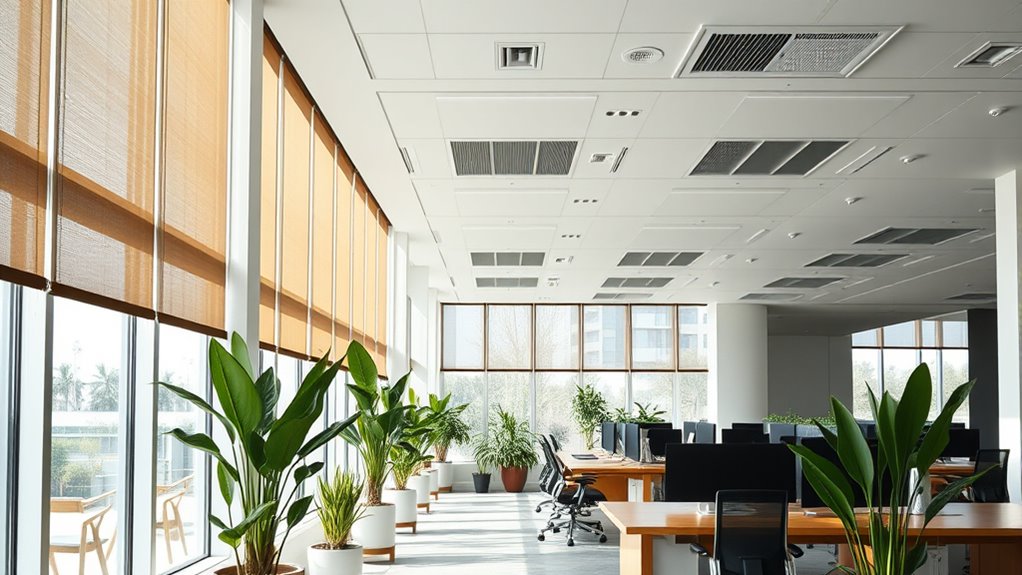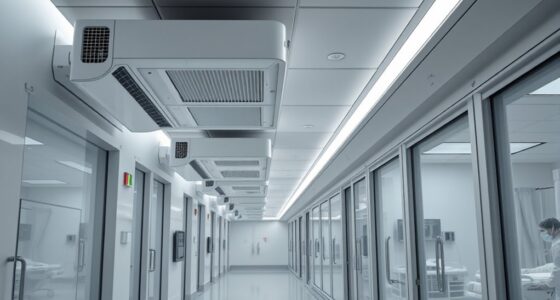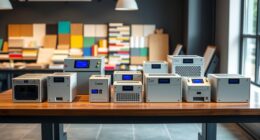Balancing energy efficiency and indoor air quality (IAQ) in commercial offices requires smart HVAC management, natural light use, and regular maintenance. You can optimize systems with occupancy sensors, adjustable controls, and strategic window placement to reduce energy waste while maintaining fresh, healthy air. Enhancing IAQ through sustainable practices benefits productivity and occupant well-being. Continue exploring how integrating these strategies can help you create a healthier, more efficient workspace.
Key Takeaways
- Implement smart HVAC controls that adjust airflow and temperature based on occupancy and outdoor conditions to optimize energy use and IAQ.
- Incorporate natural daylight through strategic window placement and shading to reduce lighting energy and improve indoor air quality.
- Use sensors for real-time monitoring of air quality and occupancy to dynamically enhance ventilation and maintain healthy indoor environments.
- Regularly maintain and upgrade HVAC systems to improve efficiency while ensuring they meet IAQ standards.
- Design flexible spaces with light-diffusing elements and proper airflow to prevent overheating, glare, and pollutant buildup.

Are commercial offices still the backbone of business operations today? For many companies, they certainly remain essential spaces where ideas are exchanged, decisions are made, and productivity is driven. But as the world shifts toward sustainability and healthier work environments, you need to think beyond just the physical space. Guaranteeing your office is energy-efficient while maintaining excellent indoor air quality (IAQ) is more important than ever. One effective way to achieve this balance is through HVAC optimization, which fine-tunes your heating, ventilation, and air conditioning systems to operate efficiently without sacrificing comfort. When you optimize HVAC, you reduce energy waste, lower operational costs, and create a more sustainable workspace. This process involves regularly maintaining your systems, upgrading to smarter controls, and adjusting settings based on occupancy and weather conditions.
Daylight integration plays an essential role in this effort. By designing your office to maximize natural light, you decrease reliance on artificial lighting, which cuts down energy consumption considerably. But daylight integration isn’t just about saving energy; it also impacts your employees’ health and productivity. When you bring in more sunlight through windows, skylights, or light shelves, you improve the overall ambiance of the space. Natural light helps regulate circadian rhythms, reducing fatigue and enhancing focus. Plus, it contributes to better IAQ by reducing the need for electrical lighting that can generate heat and sometimes pollutants. When combined with HVAC optimization, daylight integration creates a synergistic effect—less energy used for lighting and climate control means lower emissions and operational costs, all while supporting healthier indoor conditions.
Maximize natural light to boost energy efficiency, employee well-being, and indoor air quality through strategic daylight integration.
To implement these strategies effectively, you need a thoughtful approach. For HVAC, consider integrating smart sensors that monitor occupancy and air quality, allowing your system to adjust airflow and temperature dynamically. This prevents over-conditioning and ensures that fresh air circulates efficiently, reducing the risk of pollutants and stale air buildup. For daylight integration, strategic placement of windows and the use of shading devices or light-diffusing elements can maximize sunlight penetration without causing glare or overheating. These solutions work together to reduce your energy demand while improving the IAQ, creating a more comfortable, healthier environment for everyone.
In the end, balancing energy efficiency with indoor air quality in commercial offices isn’t just about cutting costs; it’s about fostering a space where employees feel good and perform at their best. HVAC optimization paired with thoughtful daylight integration offers a practical, impactful way to support your business goals while embracing sustainability and health priorities. By making these adjustments, you help guarantee your office remains a productive, inviting environment—today and into the future.
Frequently Asked Questions
How Can Smart Sensors Improve IAQ Management?
Smart sensors improve IAQ management by continuously monitoring air quality levels, allowing you to detect pollutants and VOCs in real-time. They enable ventilation optimization through occupancy detection, adjusting airflow based on actual space use. This guarantees fresh air circulation when needed, reducing energy waste. By providing precise data, smart sensors help you maintain a healthier environment while balancing energy efficiency, creating a comfortable and safe workspace for everyone.
What Are Cost-Effective Ventilation Solutions for Offices?
Think of your office ventilation like a steady breeze that keeps everyone comfortable. To save costs, focus on air filtration systems and adjusting ventilation rates based on occupancy. Using demand-controlled ventilation, inspired by smart sensors, can optimize airflow without wasting energy. This approach guarantees good IAQ, reduces energy bills, and maintains a healthy environment—making your office both efficient and comfortable for everyone.
How Does Occupancy Affect Energy and IAQ Balance?
Occupant behavior and space utilization directly impact your energy use and indoor air quality. When occupancy varies, you need flexible ventilation that adapts to real-time needs. If spaces are underutilized, overventilation wastes energy, but insufficient airflow can harm IAQ. By monitoring occupancy patterns and adjusting ventilation accordingly, you achieve a better balance, saving energy while maintaining healthy indoor air quality for everyone.
What Are the Latest Standards for Office IAQ?
Imagine your office air as a clear mountain stream—fresh and pure when well-maintained. The latest standards emphasize effective air filtration to trap indoor pollutants and guarantee good IAQ. They recommend minimum ventilation rates, proper filtration systems, and regular monitoring to keep indoor pollutants at bay. By following these guidelines, you create a healthier environment where clean air flows freely, supporting productivity and well-being for everyone inside.
How to Retrofit Older Buildings for Better Energy Efficiency?
To retrofit older buildings for better energy efficiency, start by upgrading building insulation to reduce heat loss and improve overall comfort. Consider window upgrades with energy-efficient glazing to minimize drafts and enhance insulation. Sealing gaps and adding weatherstripping also help prevent air leaks. These improvements reduce energy consumption, lower costs, and boost indoor air quality, ensuring a healthier, more sustainable workspace.
Conclusion
Balancing energy efficiency and indoor air quality in commercial offices isn’t just smart—it’s essential. Did you know that poor IAQ can reduce productivity by up to 10%? By implementing smart ventilation and energy-saving systems, you can create a healthier, more efficient workspace. Prioritizing both not only benefits your employees’ well-being but also saves costs in the long run. Remember, a well-ventilated office is a productive, happy workspace that stands out.








